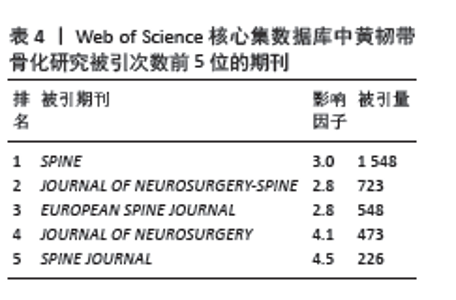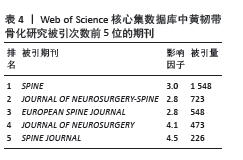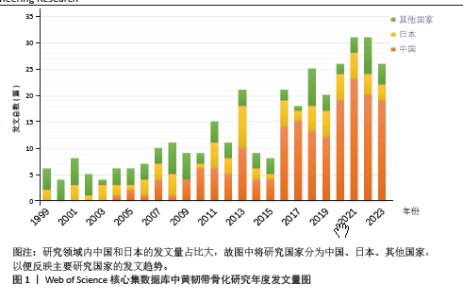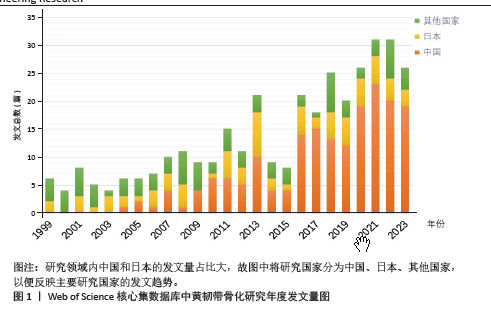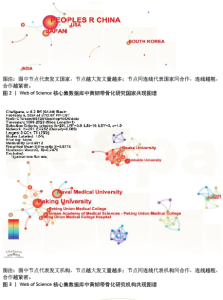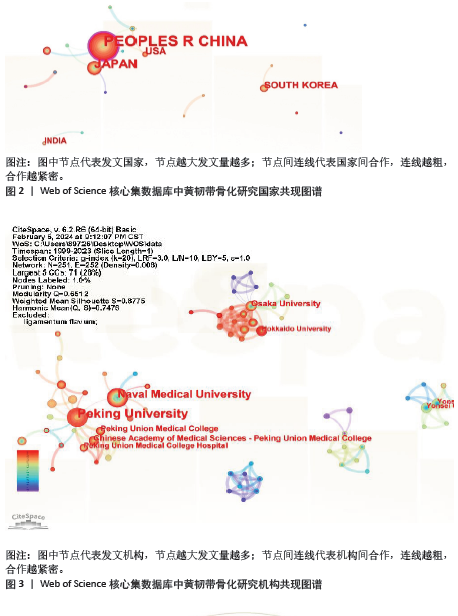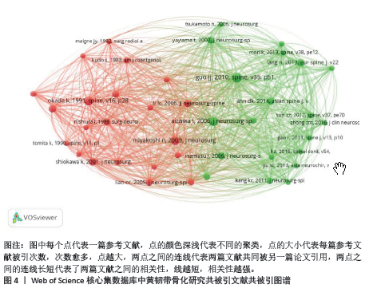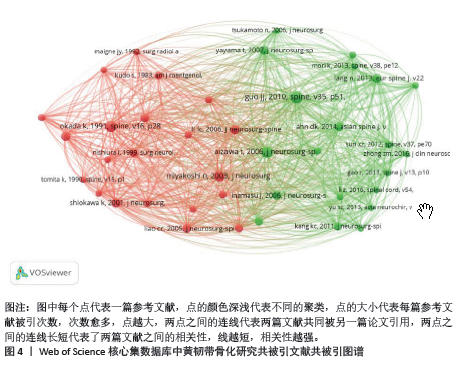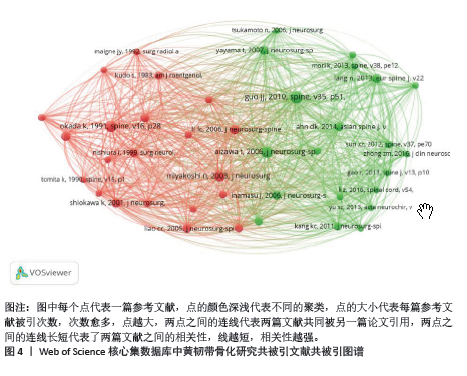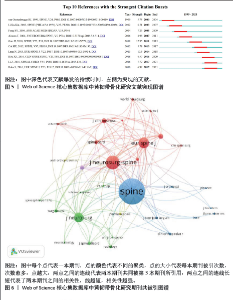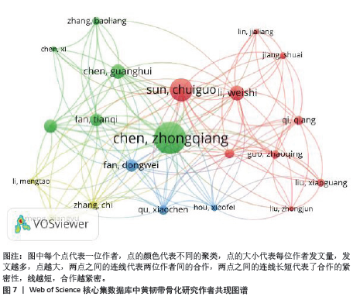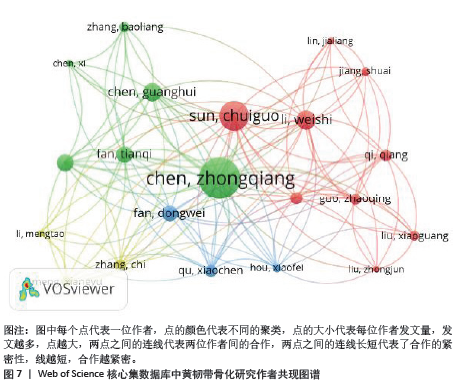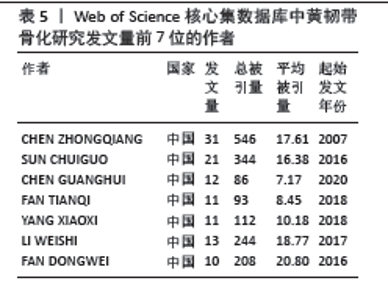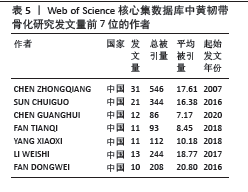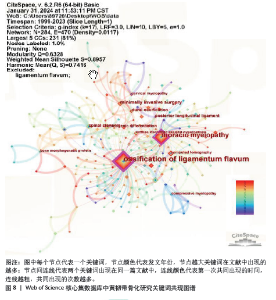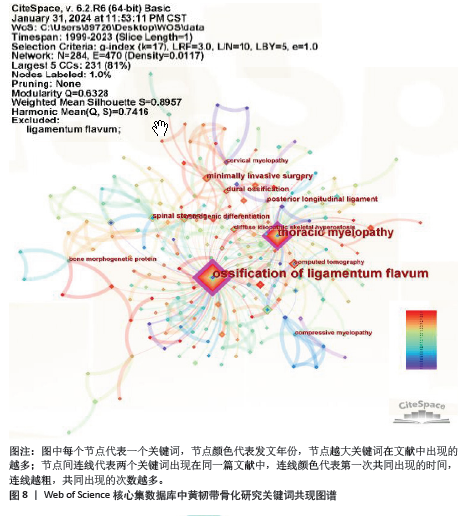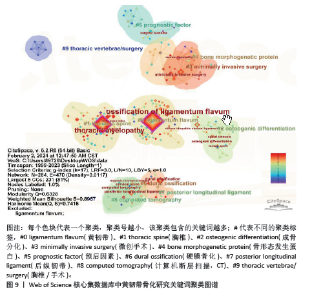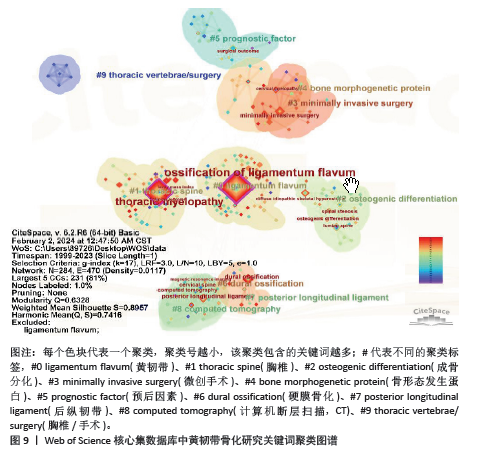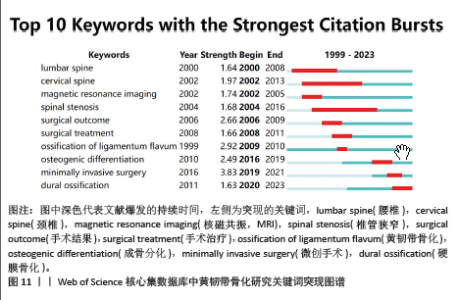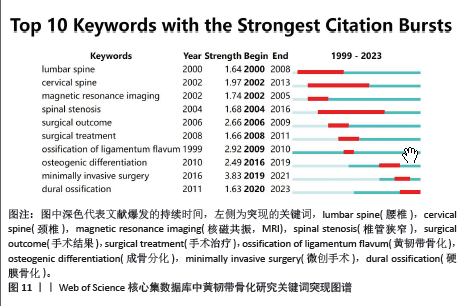Chinese Journal of Tissue Engineering Research ›› 2025, Vol. 29 ›› Issue (3): 628-636.doi: 10.12307/2025.272
Previous Articles Next Articles
Visual analysis of hot spots and trends in the study of ligamentum flavum ossification
Xu Qiang1, Qin Jialin1, 2, Lian Zeshuang1, Wang Aoting1, Li Ding1, 2, Wang Ye1, 2, Wang Junfang1, 2
- 1Nanjing Medical University, Nanjing 211166, Jiangsu Province, China; 2Wuxi People’s Hospital Affiliated to Nanjing Medical University, Wuxi 214023, Jiangsu Province, China
-
Received:2024-01-16Accepted:2024-03-22Online:2025-01-28Published:2024-06-05 -
Contact:Wang Junfang, MD, Chief physician, Master’s supervisor, Nanjing Medical University, Nanjing 211166, Jiangsu Province, China; Wuxi People’s Hospital Affiliated to Nanjing Medical University, Wuxi 214023, Jiangsu Province, China -
About author:Xu Qiang, Master candidate, Nanjing Medical University, Nanjing 211166, Jiangsu Province, China -
Supported by:Scheme for Young and Middle-Aged Top Talents of Wuxi Municipal Health Commission, No. BJ2023015 (to WJF)
CLC Number:
Cite this article
Xu Qiang, Qin Jialin, Lian Zeshuang, Wang Aoting, Li Ding, Wang Ye, Wang Junfang. Visual analysis of hot spots and trends in the study of ligamentum flavum ossification[J]. Chinese Journal of Tissue Engineering Research, 2025, 29(3): 628-636.
share this article
Add to citation manager EndNote|Reference Manager|ProCite|BibTeX|RefWorks
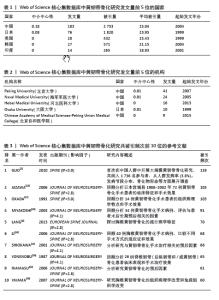
2.1 研究现状 2.1.1 年度发文量趋势 年度发文量趋势一定程度上可反映某领域的研究热度及前景,黄韧带骨化的发文量趋势见图1。自1999年来,发文量呈波动上升的趋势。1999-2006年发文量有起伏,但整体稳定在较低水平;自2007年起,发文量表现出螺旋上升的特点,个别年份出现下降,但较之2007年前的平均水平仍较高。 2.1.2 研究国家分布 黄韧带骨化研究领域发文量前5位的国家分别是中国(183篇,约占总发文量的52.74%)、日本(76篇,约占总发文量的21.90%)、美国(28篇,约占总发文量的8.07%)、韩国(27篇,约占总发文量的7.78%)、印度(14篇,约占总发文量的4.03%),见表1。检索时间范围内,日本最早开始发表该领域的研究成果(1999年,检索的起始年份),中国2004年开始发表。中国的中介中心性最高(0.18),发文量第二位的日本中心性排名第二位(0.08)。日本的文章篇均被引次数最高(23.95),韩国排名第二位(21.15),中国排名第三位(15.04)。从研究国家的共现图看,各国家的合作并不紧密,见图2。 2.1.3 研究机构分布 黄韧带骨化研究领域发文量前5位的机构排名见 表2。排名前5位的机构中,中国研究机构占4个席位,仅日本的大阪大学非中国研究机构。北京大学以41篇的发文量稳居第一,远远高于其后的机构。但就中介中心性来看,并未有特别突出的机构。 从研究机构共现图谱看,日本的机构间合作紧密和频繁,中国的研究机构发文量大,但是机构间合作较为稀少和松散,更未发现处于合作中心地位的研究机构[2,5,13,17-23],见图3。从整体看,机构间的合作出现了很强的地域性,局限于各自国家内的合作交流,缺乏国际间的沟通协作,这一点与国家共现图谱的分析吻合,见图2。 2.1.4 参考文献共被引分析/突现分析 参考文献共被引图谱见图4(图中显示的是被引频次超过30次的共被引文献即347篇文献的参考文献,包含部分1999年前的文献),被引频次前10位的参考文献见表3。被引频次前10位的参考文献中,5篇与疾病临床表现和手术治疗相关[13, 17-20], 3篇与疾病的预后因素相关[18, 21-22],2篇主要研究了疾病在中国人群中的流行病学特征[2,5],有2篇研究了疾病的组织病理学和免疫病理学[17,23] (部分文献研究主题不单一)。这些研究成果学术价值高,研究者应重点查阅。文献突现图谱见图5,文献Guo JJ(2010)被引次数最多[2], 同时突现强度也最高。文献Baba S (2016)突现年份最晚[24],研究了9例借助显微内镜通过微创手术进行后路减压的病例,突现持续了4年。 2.1.5 期刊共被引分析 黄韧带骨化研究领域期刊共被引图谱见图6,图中显示的是被引频次达35次及以上的期刊。被引频次排名前5 的期刊见表4,排名前3位的期刊为《SPINE》(被引1 548次)、《JOURNAL OF NEUROSURGERY-SPINE》(被引723次)、《EUROPEAN SPINE JOURNAL》(被引548次)。上述杂志刊载的相关研究成果质量相对高,学者可提高关注度。"
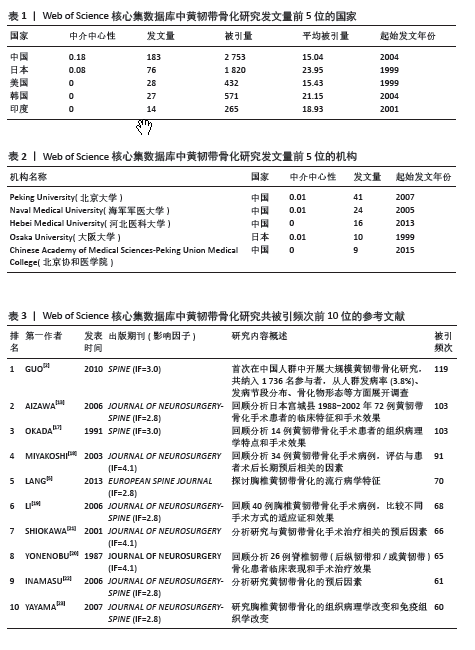
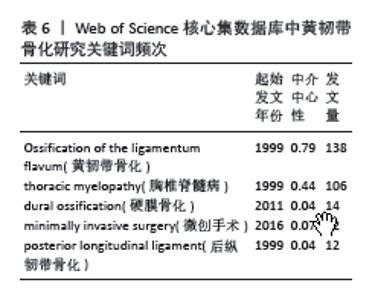
2.2 研究热点及趋势 2.2.1 关键词共现分析 关键词是对文章主题和内容的高度概括、凝练,对关键词的分析可反映领域研究的热点和趋势[25],关键词的共现见图8。关键词“黄韧带骨化”“胸椎脊髓病”“硬膜骨化”“微创手术”“手术治疗”“后纵韧带骨化”等出现频次最高,见表6。从中介中心性看,“黄韧带骨化”“胸椎脊髓病”“硬膜骨化”“微创手术”“后纵韧带骨化”在领域研究中处于中枢地位。去除与研究主题直接相关的关键词,综合词频和中介中心性的结果,“胸椎脊髓病”“硬膜骨化”“微创手术”“后纵韧带骨化”处于领域研究的核心地位。 2.2.2 关键词聚类分析 关键词的聚类分析是将彼此联系紧密的关键词进行聚类,能够反映领域研究的热点[26]。将收集的数据导入CiteSpace进行关键词聚类分析,结果见图9,聚类号越小,该聚类包含的关键词越多。共得到10个聚类,按聚类号从小到大排列聚类标签以次为:#0 ligamentum flavum(黄韧带)、#1 thoracic spine(胸椎)、#2 osteogenic differentiation(成骨分化)、#3 minimally invasive surgery(微创手术)、#4 bone morphogenetic protein(骨形态发生蛋白)、#5 prognostic factor(预后因素)、#6 dural ossification (硬膜骨化)、#7 posterior longitudinal ligament(后纵韧带)、#8 computed tomography(计算机断层扫描,CT)、#9 thoracic vertebrae/surgery(胸椎/手术)。#0,#1,#9偏重疾病的临床表现和治疗,#6,#7偏重疾病的合并症和围术期并发症,#3偏重疾病的治疗方式的进展,#2,#4偏重疾病发病机制的基础研究,#8偏重于疾病诊断,#5偏重疾病的预后因素。总的来说,研究更偏重疾病的临床表现和治疗。"
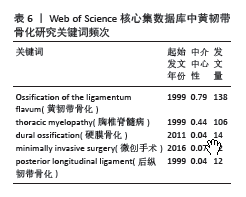
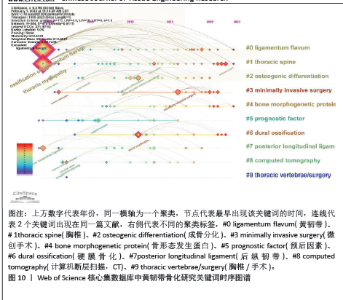
2.2.3 关键词时序分析 关键词时序图从时间维度上对关键词的出现进行排序,可形象、直观地展现领域研究的历史,帮助学者把握领域研究主题的动态演进过程,黄韧带骨化的关键词时序图谱见图10。在2005年之前,研究注重CT和MRI在疾病诊断中的作用、疾病的手术治疗,在2010年前后,疾病的微创手术治疗、佐藤分类等逐渐受到学者的重视,在2015年前后,显微内镜技术开始被应用于该疾病的手术治疗,关于疾病发病机制的基础研究一直不多,稀疏分布。 2.2.4 关键词突现分析 突现是指在一段时间内出现频次突然增加的关键词,在一定程度上很能反映研究热点和前沿,极大可能是未来研究中的重点和趋势。Web of Science核心集数据库中黄韧带骨化研究关键词突现图谱见图11。从图中可见,微创手术的突现强度(3.84)最高,在2019-2021年备受关注。关键词“硬膜骨化”尚未结束突现。"
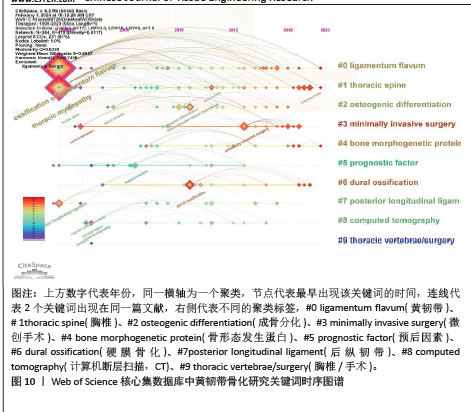
| [1] DANIELS AH, MCDONALD CL, BASQUES BA, et al. Ossified ligamentum flavum: epidemiology, treatment, and outcomes. J Am Acad Orthop Surg. 2022;30(12): e842-e851. [2] GUO JJ, LUK KD, KARPPINEN J, et al. Prevalence, distribution, and morphology of ossification of the ligamentum flavum: a population study of one thousand seven hundred thirty-six magnetic resonance imaging scans. Spine (Phila Pa 1976). 2010;35(1):51-56. [3] KUDO S, ONO M, RUSSELL WJ. Ossification of thoracic ligamenta flava. AJR Am J Roentgenol. 1983;141(1):117-121. [4] WILLIAMS D M, GABRIELSEN T O, LATACK J T, et al. Ossification in the cephalic attachment of the ligamentum flavum. An anatomical and CT study. Radiology. 1984;150(2):423-426. [5] LANG N, YUAN HS, WANG HL, et al. Epidemiological survey of ossification of the ligamentum flavum in thoracic spine: CT imaging observation of 993 cases. Eur Spine J. 2013;22(4):857-862. [6] JAFFAN I, ABU-SERIEH B, DUPREZ T, et al. Unusual CT/MR features of putative ligamentum flavum ossification in a North African woman. Br J Radiol. 2006;79(944): e67-e70. [7] CHOI YH, LEE JH, KWON YM. Prevalence, distribution, and concomitance of whole-spine ossification of the posterior longitudinal ligament and ossification of the ligament flavum in South Koreans: a whole-spine-CT-based cross-sectional study. Neurospine. 2022;19(4):1108-1115. [8] HOU X, SUN C, LIU X, et al. Clinical features of thoracic spinal stenosis-associated myelopathy: a retrospective analysis of 427 cases. Clin Spine Surg. 2016;29(2):86-89. [9] KANEYAMA S, DOITA M, NISHIDA K, et al. Thoracic myelopathy due to ossification of the yellow ligament in young baseball pitchers. J Spinal Disord Tech. 2008;21(1): 68-71. [10] PAN B, HUO T, CAO M, et al. ADAM10 promotes the proliferation of ligamentum flavum cells by activating the PI3K/AKT pathway. Int J Mol Med. 2021;47(2): 688-698. [11] TSUKAMOTO N, MAEDA T, MIURA H, et al. Repetitive tensile stress to rat caudal vertebrae inducing cartilage formation in the spinal ligaments: a possible role of mechanical stress in the development of ossification of the spinal ligaments. J Neurosurg Spine. 2006;5(3):234-242. [12] LIANG H, LIU G, LU S, et al. Epidemiology of ossification of the spinal ligaments and associated factors in the Chinese population: a cross-sectional study of 2000 consecutive individuals. BMC Musculoskelet Disord. 2019;20(1):253. [13] AIZAWA T, SATO T, SASAKI H, et al. Thoracic myelopathy caused by ossification of the ligamentum flavum: clinical features and surgical results in the Japanese population. J Neurosurg Spine. 2006;5(6):514-519. [14] AHN DK, LEE S, MOON SH, et al. Ossification of the ligamentum flavum. Asian Spine J. 2014;8(1):89-96. [15] JIANG S, LIU Y, ZHENG H, et al. Evolutionary patterns and research frontiers in neoadjuvant immunotherapy: a bibliometric analysis. Int J Surg. 2023;109(9):2774-2783. [16] 陈悦,陈超美,刘则渊,等.CiteSpace知识图谱的方法论功能[J].科学学研究, 2015,33(2):242-253. [17] OKADA K, OKA S, TOHGE K, et al. Thoracic myelopathy caused by ossification of the ligamentum flavum. Clinicopathologic study and surgical treatment. Spine (Phila Pa 1976). 1991;16(3):280-287. [18] MIYAKOSHI N, SHIMADA Y, SUZUKI T, et al. Factors related to long-term outcome after decompressive surgery for ossification of the ligamentum flavum of the thoracic spine. J Neurosurg. 2003;99(3 Suppl):251-256. [19] LI F, CHEN Q, XU K. Surgical treatment of 40 patients with thoracic ossification of the ligamentum flavum. J Neurosurg Spine. 2006;4(3):191-197. [20] YONENOBU K, EBARA S, FUJIWARA K, et al. Thoracic myelopathy secondary to ossification of the spinal ligament. J Neurosurg. 1987;66(4):511-518. [21] SHIOKAWA K, HANAKITA J, SUWA H, et al. Clinical analysis and prognostic study of ossified ligamentum flavum of the thoracic spine. J Neurosurg. 2001;94(2 Suppl): 221-226. [22] INAMASU J, GUIOT B H. A review of factors predictive of surgical outcome for ossification of the ligamentum flavum of the thoracic spine. J Neurosurg Spine. 2006;5(2):133-139. [23] YAYAMA T, UCHIDA K, KOBAYASHI S, et al. Thoracic ossification of the human ligamentum flavum: histopathological and immunohistochemical findings around the ossified lesion. J Neurosurg Spine. 2007; 7(2):184-193. [24] BABA S, OSHIMA Y, IWAHORI T, et al. Microendoscopic posterior decompression for the treatment of thoracic myelopathy caused by ossification of the ligamentum flavum: a technical report. Eur Spine J. 2016;25(6):1912-1919. [25] 侯召猛,苏少亭,陈龙豪,等.青少年特发性脊柱侧凸研究热点及趋势的可视化分析[J].中国组织工程研究,2024,28(21): 4656-4663. [26] 熊冰朗,林天烨,杨鹏,等.前交叉韧带重建国际研究现状及趋势的可视化分析[J].中国组织工程研究,2021,25(29):5396-5402. [27] ANDO K, IMAGAMA S, KAITO T, et al. Outcomes of surgery for thoracic myelopathy owing to thoracic ossification of the ligamentum flavum in a nationwide multicenter prospectively collected study in 223 patients: is instrumented fusion necessary? Spine (Phila Pa 1976). 2020;45(3):e170-e178. [28] MUTHUKUMAR N. Dural ossification in ossification of the ligamentum flavum: a preliminary report. Spine (Phila Pa 1976). 2009;34(24):2654-2661. [29] SUN X, SUN C, LIU X, et al. The frequency and treatment of dural tears and cerebrospinal fluid leakage in 266 patients with thoracic myelopathy caused by ossification of the ligamentum flavum. Spine (Phila Pa 1976). 2012;37(12):e702-e707. [30] ZHAO Y, XIANG Q, JIANG S, et al. Prevalence, diagnosis, and impact on clinical outcomes of dural ossification in the thoracic ossification of the ligamentum flavum: a systematic review. Eur Spine J. 2023;32(4):1245-1253. [31] LI B, QIU G, GUO S, et al. Dural ossification associated with ossification of ligamentum flavum in the thoracic spine: a retrospective analysis. BMJ Open. 2016;6(12):e013887. [32] CHEN G, CHEN Z, LI W, et al. Banner cloud sign: a novel method for the diagnosis of dural ossification in patients with thoracic ossification of the ligamentum flavum. Eur Spine J. 2022;31(7):1719-1727. [33] CHEN J, YU Q, WANG H, et al. Short shaft ratio: a novel predictor for dural ossification in patients with ossification of the ligamentum flavum. Heliyon. 2023; 9(8):e18541. [34] YAMADA T, SHINDO S, YOSHII T, et al. Surgical outcomes of the thoracic ossification of ligamentum flavum: a retrospective analysis of 61 cases. BMC Musculoskelet Disord. 2021;22(1):7. [35] SATO T, KOKUBUN S, TANAKA Y, et al. Thoracic myelopathy in the Japanese: epidemiological and clinical observations on the cases in Miyagi Prefecture. Tohoku J Exp Med. 1998;184(1):1-11. [36] 张保良,陈广辉,范天奇,等.胸椎黄韧带骨化分型系统的研究进展[J].中华骨科杂志,2020,40(14):962-970. [37] AIZAWA T, SATO T, SASAKI H, et al. Results of surgical treatment for thoracic myelopathy: minimum 2-year follow-up study in 132 patients. J Neurosurg Spine. 2007;7(1):13-20. [38] TAKAI K, MATSUMOTO T, YABUSAKI H, et al. Surgical complications associated with spinal decompression surgery in a Japanese cohort. J Clin Neurosci. 2016;26:110-115. [39] HOU X, CHEN Z, SUN C, et al. A systematic review of complications in thoracic spine surgery for ossification of ligamentum flavum. Spinal Cord. 2018;56(4):301-307. [40] ZHU J, LUO X, SUN K, et al. The gantry crane technique: a novel technique for treating severe thoracic spinal stenosis and myelopathy caused by ossification of the ligamentum flavum and preliminary clinical results. Global Spine J. 2023;13(2):400-408. [41] BABA S, SHIBOI R, YOKOSUKA J, et al. Microendoscopic posterior decompression for treating thoracic myelopathy caused by ossification of the ligamentum flavum: case series. Medicina (Kaunas). 2020;56(12):684. [42] AN B, LI XC, ZHOU CP, et al. Percutaneous full endoscopic posterior decompression of thoracic myelopathy caused by ossification of the ligamentum flavum. Eur Spine J. 2019;28(3):492-501. |
| [1] | Li Liangkui, Huang Yongcan, Wang Peng, Yu Binsheng. Effect of anterior controllable anteriodisplacement and fusion on vertebrae-ossification of posterior longitudinal ligament complex and implants: a finite element analysis [J]. Chinese Journal of Tissue Engineering Research, 2025, 29(9): 1761-1767. |
| [2] | Liang Haobo, Wang Zeyu, Ma Wenlong, Liu Hao, Liu Youwen. Hot issues in the field of joint revision: infection, rehabilitation nursing, bone defect, and prosthesis loosening [J]. Chinese Journal of Tissue Engineering Research, 2025, 29(9): 1963-1971. |
| [3] | Lyu Liting, Yu Xia, Zhang Jinmei, Gao Qiaojing, Liu Renfan, Li Meng, Wang Lu. Bibliometric analysis of research process and current situation of brain aging and exosomes [J]. Chinese Journal of Tissue Engineering Research, 2025, 29(7): 1457-1465. |
| [4] | Xie Liugang, Cui Shuke, Guo Nannan, Li Aoyu, Zhang Jingrui. Research hotspots and frontiers of stem cells for Alzheimer’s disease [J]. Chinese Journal of Tissue Engineering Research, 2025, 29(7): 1475-1485. |
| [5] | Chang Jinxia, Liu Yufei, Niu Shaohui, Wang Chang, Cao Jianchun. Visualization analysis of macrophage polarization in tissue repair process [J]. Chinese Journal of Tissue Engineering Research, 2025, 29(7): 1486-1496. |
| [6] | Cao Yue, Ye Xinjian, Li Biyao, Zhang Yining, Feng Jianying. Effect of extracellular vesicles for diagnosis and therapy of oral squamous cell carcinoma [J]. Chinese Journal of Tissue Engineering Research, 2025, 29(7): 1523-1530. |
| [7] | He Bo, Chen Wen, Ma Suilu, He Zhijun, Song Yuan, Li Jinpeng, Liu Tao, Wei Xiaotao, Wang Weiwei, Xie Jing . Pathogenesis and treatment progress of flap ischemia-reperfusion injury [J]. Chinese Journal of Tissue Engineering Research, 2025, 29(6): 1230-1238. |
| [8] | Li Huijun, Li Huangyan, Zhang Yeting. Physical activity and cognition in older adults: research hotspot and topic evolution [J]. Chinese Journal of Tissue Engineering Research, 2025, 29(5): 1073-1080. |
| [9] | Yu Ming, Wang Wen. Posterior cruciate ligament tibial attachment point avulsion fracture: materials, implants, and internal fixation techniques in arthroscopic treatment [J]. Chinese Journal of Tissue Engineering Research, 2025, 29(4): 872-880. |
| [10] | Dang Xiaowen, Huang Hailiang, Huang Lei, Wang Yajie . Research frontiers and hotspots of carbon nanomaterials in biomedical field over the past 10 years [J]. Chinese Journal of Tissue Engineering Research, 2025, 29(4): 752-760. |
| [11] | Ma Yucong, Ouyang Zhengzheng, Liu Xiaojie, Yang Sifei. Tracking of research trends and hotspots in medical magnesium alloy materials [J]. Chinese Journal of Tissue Engineering Research, 2025, 29(34): 7470-7480. |
| [12] | Liao Qiyu, Ru Jiangying. Complications of intra-prosthetic dissociation after hip arthroplasty [J]. Chinese Journal of Tissue Engineering Research, 2025, 29(33): 7241-7249. |
| [13] | Wang Yong, Li Hongyu, Liu Yuhang, Wang Fengxing. Knowledge map of surgical treatment for osteonecrosis of the femoral head: a bibliometric analysis of data from 2005 to 2024 [J]. Chinese Journal of Tissue Engineering Research, 2025, 29(33): 7250-7260. |
| [14] | Deng Qing, Wang Qingjun, Zhang Yeting. Visual analysis of dynamic evolution of research topics in the field of physical activity and hippocampal tissue [J]. Chinese Journal of Tissue Engineering Research, 2025, 29(32): 6997-7003. |
| [15] | Guo Haizhen, Cong Zidong, Zhao Yuke, Li Xiaofeng, Yu Lu, Qian Shule, Wang Runying, Du Wuxun. Development of patch clamp technology in the past 10 years: visual analysis based on CiteSpace and VOSviewer [J]. Chinese Journal of Tissue Engineering Research, 2025, 29(31): 6717-6726. |
| Viewed | ||||||
|
Full text |
|
|||||
|
Abstract |
|
|||||
